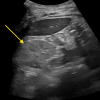Dialysis Disequilibrium Syndrome With Cerebral Edema in an Adult Patient Following the Initial Dialysis Session
- PMID: 39328632
- PMCID: PMC11424395
- DOI: 10.7759/cureus.67823
Dialysis Disequilibrium Syndrome With Cerebral Edema in an Adult Patient Following the Initial Dialysis Session
Abstract
Dialysis is a common treatment for removing toxins, electrolytes, and excess fluids due to impaired kidney function. A rare but life-threatening complication that can arise is dialysis disequilibrium syndrome (DDS) with cerebral edema. DDS is characterized by a range of neurological symptoms that may occur following dialysis. Its incidence is not well-established because it often presents with nonspecific symptoms, making diagnosis challenging. Here, we present a case of a 64-year-old female with a history of hypertension and chronic kidney disease stage 5, who sought evaluation for nausea and vomiting with coffee-ground emesis that began three weeks prior. Despite an initial blood transfusion stabilizing her hemoglobin with no further hematemesis, she developed DDS with cerebral edema after her first dialysis session. The condition was managed with 3% hypertonic saline, which quickly resolved both her cerebral edema and neurological symptoms. She tolerated subsequent dialysis sessions without complications and was discharged with a follow-up arranged with nephrology and an outpatient dialysis chair. This case report reviews the clinical features, risk factors, pathophysiology, management, and treatment goals for DDS. In patients commencing dialysis, particular attention should be given to preventing DDS, especially in those with elevated blood urea nitrogen levels above 100 mg/dL. Prompt recognition and treatment are crucial to balance the osmotic gradient and prevent severe outcomes, such as cerebral edema and death.
Keywords: chronic kidney disease (ckd); dialysis; dialysis disequilibrium syndrome; diffuse cerebral edema; reverse urea effect.
Copyright © 2024, Patel et al.
Conflict of interest statement
Human subjects: Consent was obtained or waived by all participants in this study. Conflicts of interest: In compliance with the ICMJE uniform disclosure form, all authors declare the following: Payment/services info: All authors have declared that no financial support was received from any organization for the submitted work. Financial relationships: All authors have declared that they have no financial relationships at present or within the previous three years with any organizations that might have an interest in the submitted work. Other relationships: All authors have declared that there are no other relationships or activities that could appear to have influenced the submitted work.
Figures



Similar articles
-
Dialysis disequilibrium syndrome and other treatment complications of extreme uremia: a rare occurrence yet not vanished.Hemodial Int. 2008 Jul;12(3):301-6. doi: 10.1111/j.1542-4758.2008.00270.x. Hemodial Int. 2008. PMID: 18638082
-
Dialysis disequilibrium syndrome in neurosurgery: literature review and illustrative case example.Geroscience. 2024 Dec;46(6):5431-5437. doi: 10.1007/s11357-024-01109-z. Epub 2024 Mar 15. Geroscience. 2024. PMID: 38488947 Free PMC article. Review.
-
Cerebral Edema in a Child after Preemptive Kidney Transplantation.J Pediatr Intensive Care. 2017 Jun;6(2):123-126. doi: 10.1055/s-0036-1584682. Epub 2016 Jun 20. J Pediatr Intensive Care. 2017. PMID: 31073435 Free PMC article.
-
Recovery of severe dialysis disequilibrium syndrome with uncal herniation following therapy with mannitol, hyperventilation and hypertonic saline.Clin Kidney J. 2021 Sep 7;15(1):165-167. doi: 10.1093/ckj/sfab165. eCollection 2022 Jan. Clin Kidney J. 2021. PMID: 35035947 Free PMC article.
-
Dialysis disequilibrium syndrome prevention and management.Int J Nephrol Renovasc Dis. 2019 Apr 30;12:69-77. doi: 10.2147/IJNRD.S165925. eCollection 2019. Int J Nephrol Renovasc Dis. 2019. PMID: 31118737 Free PMC article. Review.
References
-
- Dialysis disequilibrium syndrome (DDS) in pediatric patients on dialysis: systematic review and clinical practice recommendations. Raina R, Davenport A, Warady B, et al. Pediatr Nephrol. 2022;37:263–274. - PubMed
-
- Bhandari B, Komanduri S. StatPearls [Internet] Treasure Island (FL): StatPearls Publishing; 2024. Dialysis disequilibrium syndrome. - PubMed
-
- Urea levels in cerebrospinal fluid after haemodialysis. Kennedy AC, Linton AL, Eaton JC. Lancet. 1962;1:410–411. - PubMed
-
- Dialysis disequilibrium syndrome: current concepts on pathogenesis and prevention. Arieff AI. Kidney Int. 1994;45:629–635. - PubMed
Publication types
LinkOut - more resources
Full Text Sources
